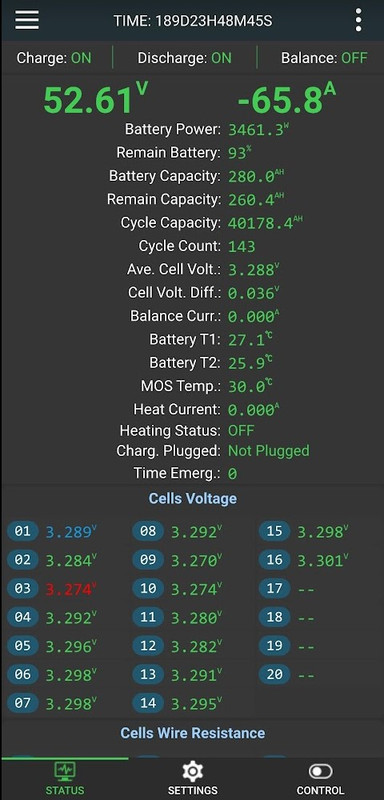| When | Battery Volt Curr Tempr Base State Volt. State Curr. State Temp. State Coulomb | Volt | mAh | Wh | << bat 1 || bat 2 >> | Battery Volt Curr Tempr Base State Volt. State Curr. State Temp. State Coulomb | Volt | mAh | Wh |
08/08/2023 19:05 | 0 3314 -3216 19000 Dischg Normal Normal Normal 96% 96351 mAH | 3314 | 96351 | 319.31 | | 0 3313 -2600 19000 Dischg Normal Normal Normal 98% 98258 mAH | 3313 | 98258 | 325.53 |
08/08/2023 19:05 | 1 3314 -3216 19000 Dischg Normal Normal Normal 96% 96351 mAH | 3314 | 96351 | 319.31 | | 1 3314 -2600 19000 Dischg Normal Normal Normal 98% 98258 mAH | 3314 | 98258 | 325.63 |
08/08/2023 19:05 | 2 3315 -3216 19000 Dischg Normal Normal Normal 96% 96351 mAH | 3315 | 96351 | 319.40 | | 2 3315 -2600 19000 Dischg Normal Normal Normal 98% 98258 mAH | 3315 | 98258 | 325.73 |
08/08/2023 19:05 | 3 3315 -3216 19000 Dischg Normal Normal Normal 96% 96351 mAH | 3315 | 96351 | 319.40 | | 3 3314 -2600 19000 Dischg Normal Normal Normal 98% 98258 mAH | 3314 | 98258 | 325.63 |
08/08/2023 19:05 | 4 3315 -3216 19000 Dischg Normal Normal Normal 96% 96351 mAH | 3315 | 96351 | 319.40 | | 4 3314 -2600 19000 Dischg Normal Normal Normal 98% 98258 mAH | 3314 | 98258 | 325.63 |
08/08/2023 19:05 | 5 3315 -3216 19000 Dischg Normal Normal Normal 96% 96351 mAH | 3315 | 96351 | 319.40 | | 5 3315 -2600 19000 Dischg Normal Normal Normal 98% 98258 mAH | 3315 | 98258 | 325.73 |
08/08/2023 19:05 | 6 3315 -3216 19000 Dischg Normal Normal Normal 96% 96351 mAH | 3315 | 96351 | 319.40 | | 6 3314 -2600 19000 Dischg Normal Normal Normal 98% 98258 mAH | 3314 | 98258 | 325.63 |
08/08/2023 19:05 | 7 3315 -3216 19000 Dischg Normal Normal Normal 96% 96351 mAH | 3315 | 96351 | 319.40 | | 7 3314 -2600 19000 Dischg Normal Normal Normal 98% 98258 mAH | 3314 | 98258 | 325.63 |
08/08/2023 19:05 | 8 3314 -3216 19000 Dischg Normal Normal Normal 96% 96351 mAH | 3314 | 96351 | 319.31 | | 8 3314 -2600 19000 Dischg Normal Normal Normal 98% 98258 mAH | 3314 | 98258 | 325.63 |
08/08/2023 19:05 | 9 3314 -3216 19000 Dischg Normal Normal Normal 96% 96351 mAH | 3314 | 96351 | 319.31 | | 9 3314 -2600 19000 Dischg Normal Normal Normal 98% 98258 mAH | 3314 | 98258 | 325.63 |
08/08/2023 19:05 | 10 3314 -3216 19000 Dischg Normal Normal Normal 96% 96351 mAH | 3314 | 96351 | 319.31 | | 10 3314 -2600 19000 Dischg Normal Normal Normal 98% 98258 mAH | 3314 | 98258 | 325.63 |
08/08/2023 19:05 | 11 3314 -3216 19000 Dischg Normal Normal Normal 96% 96351 mAH | 3314 | 96351 | 319.31 | | 11 3314 -2600 19000 Dischg Normal Normal Normal 98% 98258 mAH | 3314 | 98258 | 325.63 |
08/08/2023 19:05 | 12 3314 -3216 19000 Dischg Normal Normal Normal 96% 96351 mAH | 3314 | 96351 | 319.31 | | 12 3314 -2600 19000 Dischg Normal Normal Normal 98% 98258 mAH | 3314 | 98258 | 325.63 |
08/08/2023 19:05 | 13 3314 -3216 19000 Dischg Normal Normal Normal 96% 96351 mAH | 3314 | 96351 | 319.31 | | 13 3315 -2600 19000 Dischg Normal Normal Normal 98% 98258 mAH | 3315 | 98258 | 325.73 |
08/08/2023 19:05 | 14 3314 -3216 19000 Dischg Normal Normal Normal 96% 96351 mAH | 3314 | 96351 | 319.31 | | 14 3314 -2600 19000 Dischg Normal Normal Normal 98% 98258 mAH | 3314 | 98258 | 325.63 |
08/08/2023 19:05 | 15 3315 -3216 19000 Dischg Normal Normal Normal 96% 96351 mAH | 3315 | 96351 | 319.40 | | 15 3314 -2600 19000 Dischg Normal Normal Normal 98% 98258 mAH | 3314 | 98258 | 325.63 |
09/08/2023 18:33 | 0 3465 0 26000 Idle Normal Normal Normal 99% 99394 mAH | 3465 | 99394 | 344.40 | | 0 3473 296 26000 Charge Normal Normal Normal 100% 99400 mAH | 3473 | 99400 | 345.22 |
09/08/2023 18:33 | 1 3458 0 26000 Idle Normal Normal Normal 99% 99394 mAH | 3458 | 99394 | 343.70 | | 1 3465 296 26000 Charge Normal Normal Normal 100% 99400 mAH | 3465 | 99400 | 344.42 |
09/08/2023 18:33 | 2 3462 0 26000 Idle Normal Normal Normal 99% 99394 mAH | 3462 | 99394 | 344.10 | | 2 3460 296 26000 Charge Normal Normal Normal 100% 99400 mAH | 3460 | 99400 | 343.92 |
09/08/2023 18:33 | 3 3466 0 26000 Idle Normal Normal Normal 99% 99394 mAH | 3466 | 99394 | 344.50 | | 3 3460 296 26000 Charge Normal Normal Normal 100% 99400 mAH | 3460 | 99400 | 343.92 |
09/08/2023 18:33 | 4 3462 0 26000 Idle Normal Normal Normal 99% 99394 mAH | 3462 | 99394 | 344.10 | | 4 3461 296 26000 Charge Normal Normal Normal 100% 99400 mAH | 3461 | 99400 | 344.02 |
09/08/2023 18:33 | 5 3455 0 27000 Idle Normal Normal Normal 99% 99394 mAH | 3455 | 99394 | 343.41 | | 5 3462 296 26000 Charge Normal Normal Normal 100% 99400 mAH | 3462 | 99400 | 344.12 |
09/08/2023 18:33 | 6 3457 0 27000 Idle Normal Normal Normal 99% 99394 mAH | 3457 | 99394 | 343.61 | | 6 3464 296 26000 Charge Normal Normal Normal 100% 99400 mAH | 3464 | 99400 | 344.32 |
09/08/2023 18:33 | 7 3465 0 27000 Idle Normal Normal Normal 99% 99394 mAH | 3465 | 99394 | 344.40 | | 7 3465 296 26000 Charge Normal Normal Normal 100% 99400 mAH | 3465 | 99400 | 344.42 |
09/08/2023 18:33 | 8 3460 0 27000 Idle Normal Normal Normal 99% 99394 mAH | 3460 | 99394 | 343.90 | | 8 3473 296 26000 Charge Normal Normal Normal 100% 99400 mAH | 3473 | 99400 | 345.22 |
09/08/2023 18:33 | 9 3467 0 27000 Idle Normal Normal Normal 99% 99394 mAH | 3467 | 99394 | 344.60 | | 9 3457 296 26000 Charge Normal Normal Normal 100% 99400 mAH | 3457 | 99400 | 343.63 |
09/08/2023 18:33 | 10 3466 0 26000 Idle Normal Normal Normal 99% 99394 mAH | 3466 | 99394 | 344.50 | | 10 3469 296 24000 Charge Normal Normal Normal 100% 99400 mAH | 3469 | 99400 | 344.82 |
09/08/2023 18:33 | 11 3466 0 26000 Idle Normal Normal Normal 99% 99394 mAH | 3466 | 99394 | 344.50 | | 11 3461 296 24000 Charge Normal Normal Normal 100% 99400 mAH | 3461 | 99400 | 344.02 |
09/08/2023 18:33 | 12 3465 0 26000 Idle Normal Normal Normal 99% 99394 mAH | 3465 | 99394 | 344.40 | | 12 3456 296 24000 Charge Normal Normal Normal 100% 99400 mAH | 3456 | 99400 | 343.53 |
09/08/2023 18:33 | 13 3463 0 26000 Idle Normal Normal Normal 99% 99394 mAH | 3463 | 99394 | 344.20 | | 13 3467 296 24000 Charge Normal Normal Normal 100% 99400 mAH | 3467 | 99400 | 344.62 |
09/08/2023 18:33 | 14 3472 0 26000 Idle Normal Normal Normal 99% 99394 mAH | 3472 | 99394 | 345.10 | | 14 3461 296 24000 Charge Normal Normal Normal 100% 99400 mAH | 3461 | 99400 | 344.02 |
09/08/2023 18:33 | 15 3457 0 26000 Idle Normal Normal Normal 99% 99394 mAH | 3457 | 99394 | 343.61 | | 15 3471 296 24000 Charge Normal Normal Normal 100% 99400 mAH | 3471 | 99400 | 345.02 |
| | | | | | | | | |
| Sum Ifs | bat 1 | bat 2 | | | | | | |
| 08/08/2023 19:05 | 5,109.59 | 5,210.23 | | | | | | |
| 09/08/2023 18:33 | 5,507.02 | 5,509.25 | | | | | | |










